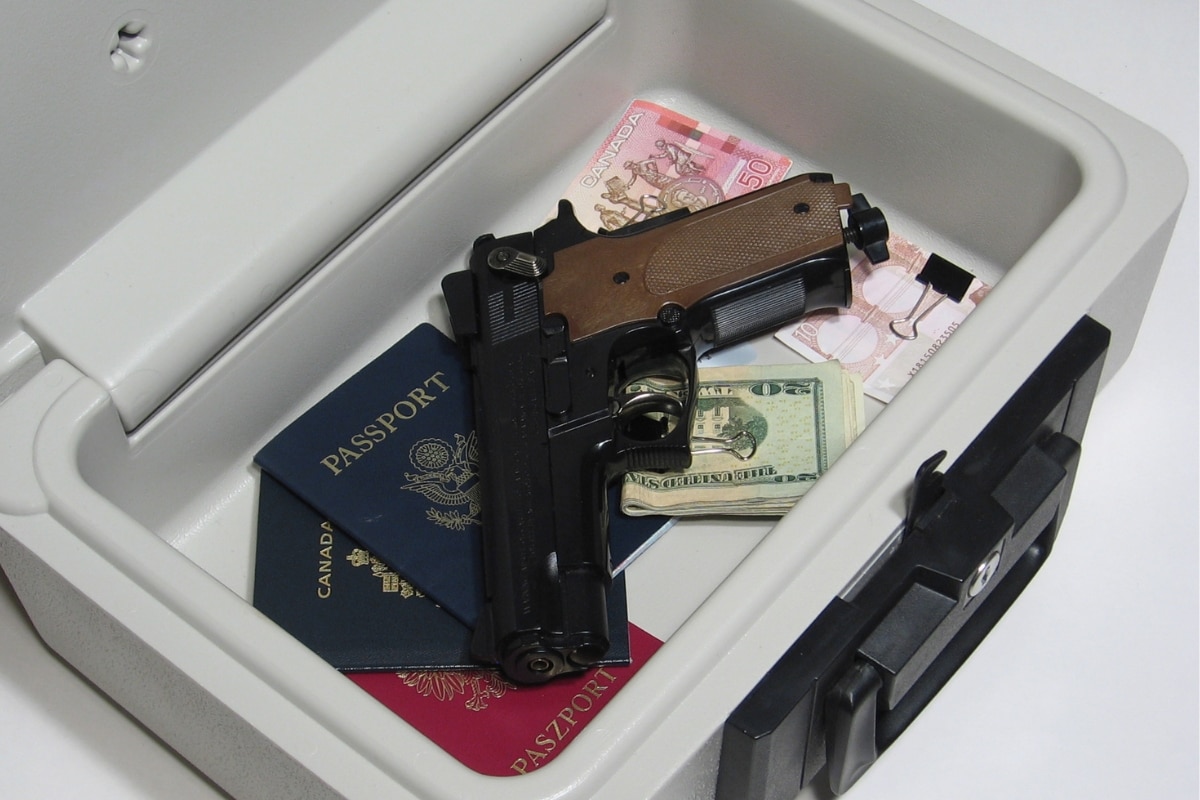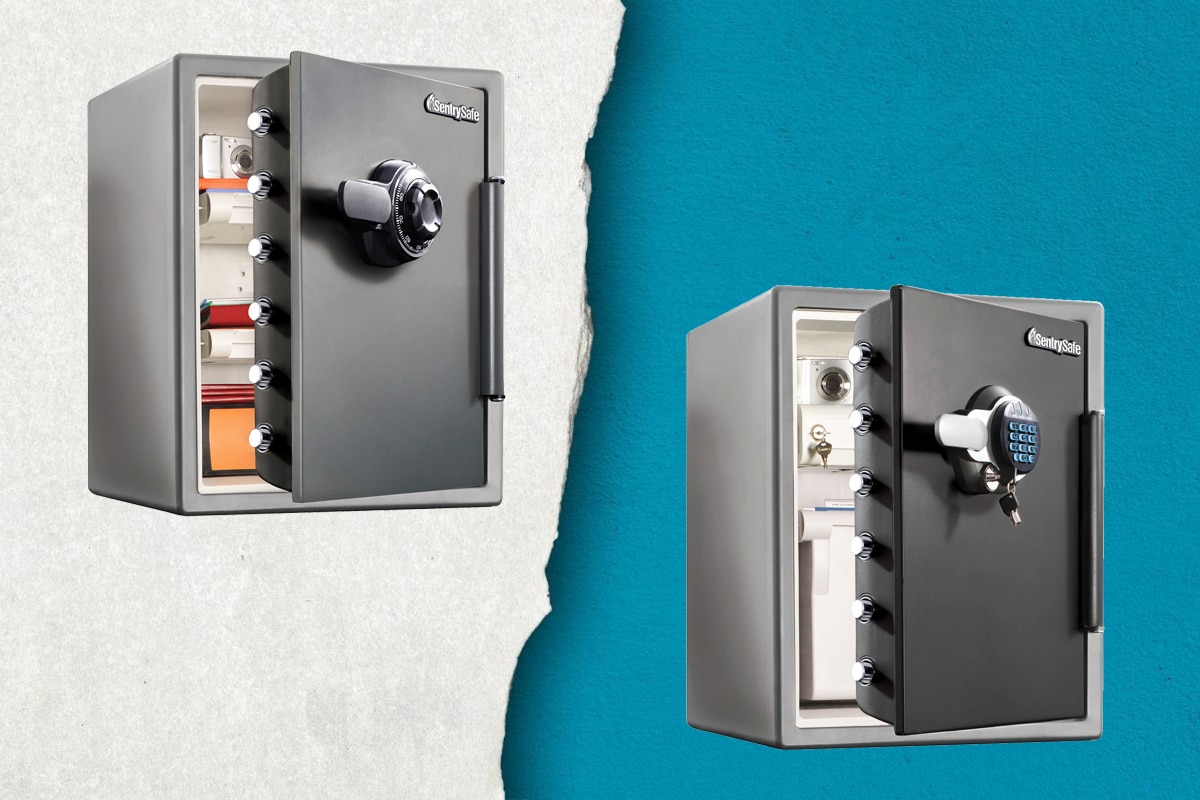A common debate I see on the internet is that people are claiming the SentrySafe is low quality with plastic and form materials, which is not competent for being a “safe”.
But the point is that most fireproof or fire-resistant safes are built for storing files and documents, which are more fragile to fire attacks. And to provide good fire-resistant performance, form is often used as the filling material, which makes the safe seems weak and easy to break.
Of course, there are heavy-duty fireproof safes, such as fireproof gun safes, which are strong enough, but they are not built for storing files in the offices. And most of these fireproof safes are not ideal for storing guns, and you should consider buying gun safes for your specific purpose, such as a quick access gun safe.
You could buy the first cheap home fire safe you see and call it a day. Unfortunately, that might or might not protect your valuables in the case of fire or flood. Personally, I can’t see taking the risk.
The whole point of getting a fire safe is, to heed the name, keep irreplaceable or expensive items safe from fire or water damage. Just any old box won’t do the trick. So, if you’re willing to invest a few minutes into research, what should you look for?
Construction Design
The obvious criteria for a good safe are obvious to the eye and hand. If it’s solid, heavy, and shows no light cracks you’re on your way. But what do those really consist of? And is that enough?
Your first thought might be that it should be heavy so it can’t be carted away by burglars. That criteria is valid, but if you bolt the safe to a solid floor – as you should – that is a lesser consideration. More important are strength and solidity, so the door can’t be easily pried open with a crowbar and hammer.
A well-made home fire safe will be, ironically, first and foremost impervious to water. That might seem paradoxical since your prime goal is to protect against fire. But it does no good to keep the heat away from your paper documents or electronic devices if putting out the flames – almost always done with water – ruins the precious material inside.
Fortunately, modern fire safes are not just great at insulating the interior from high heat. The door/box geometry, materials, and overall enclosure design keeps water at bay at the same time the safe minimizes thermal transfer.
Think, for example, of the times you’ve seen a safe door open on a bank vault. It always looks like a set of steps placed sideways, a series of convoluted door layers meeting frame layers. Even when they’re machined so precisely that zero air, water, or light leaks inside, the outermost one is still generally ringed by a rubberized seal. A well-built fire-resistant safe for the home will do something similar.
The material or method of construction is important, too. Most fire safes contain insulation or fireboard, reinforced fireboard, composite, and/or composite fire cladding (covering). The best safes use the final method, but naturally, they tend to cost more. It’s generally worth it.
A UL rated composite fire safe will sometimes have two skins of shaped metal. They typically sandwich a concrete and vermiculite material inside. That traps any water that makes it through the outer seal and, from the heat, re-directs it outward as steam. At the same time, the heat will tend to expand the door jamb, making for an even tighter seal.
Beyond waterproofing, that “self-sealing” character works in conjunction with the thermal-insulating ability of the material to stave off heat transfer. The exterior temperature of an average fire is around 800 °F, but the interior of your safe can remain a relatively comfortable 125 °F – 350 °F with this method.
Many more modest-price safes will use a tough plastic resin rather than steel. They can still be plenty heavy and well insulated, but the resin itself will melt, of course. Also, when it does, it gives off toxic fumes. You won’t generally be around, so it’s not a safety issue, but the odor after the fire is extinguished can linger. The lower price can represent a valid tradeoff, however.
After that, issues like size and weight then become more personal, secondary criteria. Those depend on how much you need to store, where the safe needs to be placed in your home, whether you’ll need to relocate it, and other issues.
That said, all other things equal, heavier is usually better. Apart from being difficult to cart away by a thief, high weight signals more material. The best safes are made of steel and contain composite concrete. Putting those together in one product produces an even heavier unit. And, aside from being harder to break into than a plastic-clad safe, the material can provide better thermal insulation. So, in that sense, “heavier” equals “more fire secure”.
What constitutes a “good size” is a matter of how large you need it to be. But thickness is a matter of security. Look for a safe with at least a 1/2″ thick door and sidewalls of at least 1/4″. And, be sure not to assume that the number stated for the door applies to the walls. Look for both specs.
UL Ratings
The material and design will produce a safe that is then tested by some lab. The best models go through rigorous testing by Underwriters Laboratories before one is put onto the market for sale. For most home fire safes that usually comes down to one of two major rating figures with some added qualifiers: UL 125 or UL 350.
A UL Class 350 safe carries that designation because it’s designed to ensure that the interior temperature gets no more than 350 °F. That is well suited to paper documents since they “auto-ignite” (i.e. burn without being directly touched by flame) at around 425-450 °F.
Electronic devices – thumb drives, hard drives, phones, tablets, and other related items – are actually more sensitive to heat. Glass, metal, and good plastic won’t burn (i.e., melt) as readily as paper, but the interior components of the device are more easily damaged by heat. So, they require a fire safe with a superior rating if they’re to be protected.
So, it turns out the numbers can be a little confusing. A home media safe with a lower number – UL Class 125 – actually provides more protection. It’s built to ensure that the temperature inside reaches no more than 125 °F.
But there is another number, important but less obvious, you’ll see associated with safes: time. It matters how hot the interior gets, certainly. But it’s also critical how long the hot air is in contact with your valuables.
There’s a complicated physical relationship between the two, described by complex mathematics, but that need not concern you. All you need to do is take a look at the number the manufacturer obligingly provides.
Most safes will have ratings that, along with the temperature class, state a time range – usually from 30 minutes to four hours. That’s a way for manufacturers to indicate how long, say, your paper documents can sit before being singed by high heat. A given UL 350 safe may protect them, for example, for only an hour. Another model may keep them cozy for 2, 3, or even 4 hours before the edges start to get crisp.
Naturally, the longer the better. It provides more time to extinguish the fire before your documents or backup thumb drive gets damaged. Unsurprisingly, you might have to pay more for a safe that’s rated with a longer time. As with any such product, you have to balance likely risk against your budget in your personal circumstances.
Keep in mind when you do, though, that it’s a rare blaze that can be put out in as quick as an hour. If it’s a small fire and you have a home fire extinguisher, and you’re around to see it, no problem. If you’re not at home and the neighbors have to call the fire department it can obviously take longer.
Only you can decide how much protection you need, and at what cost, based on what you plan to store in your fire safe.
Locking Mechanism
When researching what safe to buy, make sure to investigate all the aspects. One key feature that buyers sometimes overlook is the quality of the lock. Not all are created equal. Don’t forget that you have to get stuff into and out of the safe from time to time. If you can’t open it, your media safe is worse than useless.
Sadly, though the last point should be obvious, many buyers simply assume the lock will always work well. Unfortunately, experience shows otherwise. A safe without UL approval, for instance, is highly likely to be from China. Locks made there are improving but still don’t always have the quality of their counterparts in the U.S. Sometimes, they’re cheap plastic and have a kind of rough feel when turned. That’s a sign of poor quality.
When a lock fails on a safe there is usually only one way to get it open: force. Sometimes a locksmith can enter the safe without destroying its integrity, but rarely. Even when they can, you’ll be paying for a service call from a specialist. Those visits are not cheap.
Once the locksmith is done, you’ll still be faced in almost all cases with the need to buy a new safe. That is what was once commonly called “penny wise and pound foolish” – i.e., you spent a lot to save a little – and wound up paying much more in the long run.
Other Aspects
If you’re willing to take the time to research, in order to buy a good safe, take just a little more time. Investigate some aspects that are not usually highlighted. After you look at the UL rating, the size and weight, the lock quality, and the like, think about how the safe would work in your home or office.
Ensure, for example, that it can be bolted to the floor. Think about whether its size will allow it to be installed yet maintain the right space around it. Consider how much weight the floor will bear where you plan installation.
Decide what, and how much, you plan to put into the safe. Is it chiefly for paper, or electronics, or jewelry, or what? Do you have old photo negatives or precious family paper photos you want to keep safe? Those all have their own temperature/rating requirements.
Do you need internal partitions and spaces to keep things organized? Many safes have adjustable or removable shelves, drawers, and so forth. Many, but not all, and some are adjustable but not removable.
What sort of “accessories” do you want: electronic controls, backlighting, key override access, and more? How much are your valuables worth versus the price of the safe you are considering? How much at risk – of theft, fire, or flood (or earthquake damage) – are your valuables?
Answers to all that will help guide your budget considerations in purchasing the best safe for your needs.









